|
62. Polyommatus icarus (Rottemburg, 1775) / Common blue / Lycaenidae – Polyommatinae
NL: icarusblauwtje / D: Hauhechelbläuling, Gemeiner Bläuling / F: azuré commun, l’argus icare, l’azuré de la bugrane
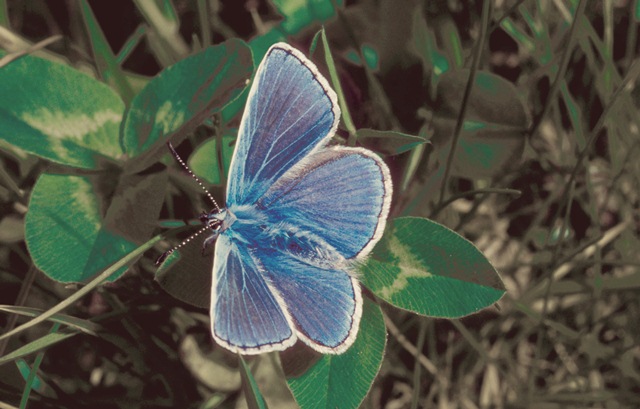  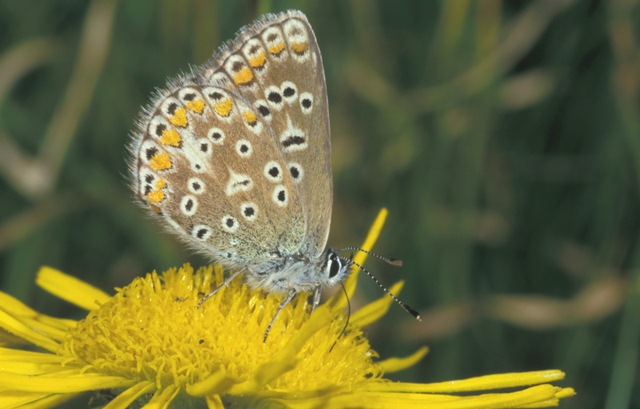
Photographs: Frits Bink ©.
Small, wing length 15 (13-16) mm. A very common species everywhere in the Benelux, a pioneer in newly created short grass vegetation containing food plants, roadside verges, fallow ground, sometimes also in heathland, if hare’s-foot clover is present.
Butterfly is on the wing from mid-May until mid-September and peaks early-June and mid-August. It is known from maritime to severe continental climates, amplitude 4 to 20. Required heat sum 300°d and maximum tolerated 3000°d, corresponding climate windows are 17 weeks and whole year open.
This blue is the most widespread of the European Lycaenids, from beyond the North polar circle up to the mountains of North-Africa. There is no special trait that may help to explain its extraordinarily ecological adaptability; this cannot be explained by any particular specialities but merely by its capability to adapt to many different habitats.
Ecological characteristics
Behaviour over time
Overwintering: larva in third instar hidden in litter layer.
Reproduction: oviposition starts after 6-8- days when the body contains 118 (107-129) eggs, estimated production 1.5 times as much.
Larval feeding periods: summer brood 4-8 weeks, overwintering generation 32 (20-44) days in autumn and 40 (35-50) days in spring.
Generations: two, three in warm summers.
Spreading of risk: flexibility in diapause.
Life cycle: egg 6 (5-12) days; larva summer brood 28 (21-57) days, hibernating one 34-46 weeks; pupa 12 (9-24) days.
Life span of adult: rather long, 3 weeks, sometimes longer, up to 4 weeks.
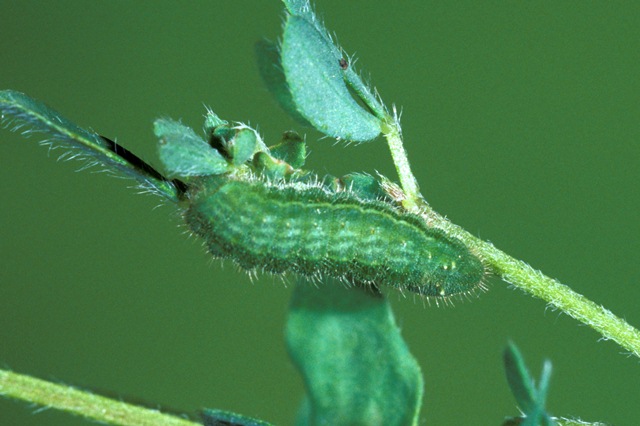 
Photographs: Frits Bink ©.
Behaviour in space
From stay-at-home to migrant: stay-at-home, spatial requirement very modest.
Finding a mate: male perches and patrols, also congregates in the roosts.
Orientation in the landscape: edges or mosaic patterns in short vegetation.
Oviposition: usually on the upper side of a young leaf or near a flower bud.
Defence
Threats from other organisms: in the urban area avian predation in early summer when birds have young.
Myrmecophily: moderate, full array of ant-attracting and appeasing organs present.
Threats from the environment: endure heat and drought quite well.
Feeding habits
Adult: nectar of all kind of flowers.
Larva: young larvae starts to feed on the underside of a leaflet, excavating the soft mesophyll and leaves the upper epidermis intact, creating silvery blotches on the leaves.
Larval foodplants
Plant species: Fabaceae, e.g. Lotus corniculatus, L. glaber, L. pendiculatus, Medicago lupulina, M. sativa, Ornithopus perusillus, Securigera varia, Trifolium arvense, T.dubium, T. pratense, T. repens.
Journal
Rearing experiments:
1. Based on specimens from Leersum, Netherlands:
6 August 1981: three females captured in garden.
8 August: eggs on bird’s-foot trefoil.
30 August: larvae end second and early third instar.
18 September: all larvae in diapause.
Overwintered in fridge.
11 February 1982: larvae taken out of the fridge.
21 February: no feeding activity, all larvae have moved from the wilted leaves, their overwintering place.
11 March: larvae in last instar preferred to eat lucerne. In the case of trefoil buds and stems were eaten.
21 March: first larva pupated.
27 March: second pupa, one larva cannibalistic.
11 April: two adults appeared.
2. Based on specimen from Leersum, Netherland:
10 June 1986: female captured in garden.
11 June: 44 eggs laid on bird’s-foot trefoil.
17 June: eggs hatched.
24 June: larvae in third instar.
2 July: first prepupa.
8 July: 14 pupae, four prepupae, three larvae were still feeding on shoots. No larvae entered diapause.
16 July: two adults appeared.
17 July: two females and three males hatched.
22 July: last pupa hatched.
Table 62-1. Results of dissections
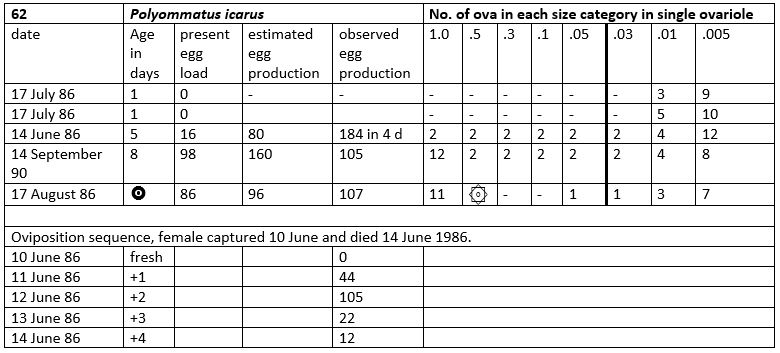
Table 62-2. Collection and observation localities
B, Theux 50° 33’ 20”N – 5° 49’ 50”E; 30 April 1983, 17 June 1983.
B, Torgny, 237 m, 49° 30’ 40”- 5° 29’ 04”E; 19 June 1983, 1 July 2002.
D, Blankenheim 50° 22’ 40”N – 6° 41’ 05”E; 20 June 1983.
D, Kaub 50° 05’ 36”N – 7° 45’ 43”E; 26 May 1986.
D, Meetschow 53° 02’ 32”N – 11° 23’ 32”E; 22 June 1984.
DK, Ørnhej 56° 13´ 06”N – 8° 34´ 00”E; 13 June 2004.
EST, Pööravere 58° 40’ 25”N – 24° 36’ 50”E; 16 July 1999.
F, Aurel, 400 m, 44° 43’N – 5° 16’E; 29 August 1984.
F, la Bruyère 45° 39’ 01”N – 5° 38’ 09”E; 25 August 1984.
F, Brittany, Telgruc-sur- Mer 48° 12’ 25”N – 4° 22’ 25”W; 29 September 2004.
F, la Grande Brière 47° 23’ 42”N – 2° 17’ 22”W; 24 September 2004.
F, Lorraine, Rupt devant Saint-Mihiel, 280 m, 48° 53’ 01”N – 5° 24’ 10”E; 28 June 2006.
F, Montmédy, 217 m, 49° 31’ 07”N – 5° 21’ 33” E; 18 August 1984.
F, Normandy, Havre de Surville 49° 16’ 47”N – 1° 40’ 23”W; 19 September 2005.
F, Normandy, Mare de Vauville 49° 37’ 55”N – 1° 50’ 56”W; 3 June 2000.
F, Normandy, Saint-Germain-sur-Ay-Plage 49° 13’ 13”N – 1° 37’ 36”W; 31 May 2000.
F, Vosges, Bollenberg, 363 m, 47° 56’ 54”N – 7° 15’21”E; 25 July 1983, 11 June 1984.
F, Vosges, Wasserbourg, 500 m, 48° 00’ 13”N – 7° 09’ 46”E; 21 August 1984.
F, Vosges, Zimmerbach, 270 m, 48° 04’ 25”N – 7° 14’ 45”E; 11 June 1984.
F, Vosges, le Zinnkoepfle, 481 m 47° 57’ 56”N – 7° 15’ 08”E; 10 July 1984.
GB, Oxford, Great Wood 51° 41’N – 0° 55’W; 20 July 1981.
NL, Amerongen, garden, 52° 00’ 01”N – 5° 27’ 34”E; 1975-1986.
NL, Bennekom, garden, 51° 59’ 30”N – 5° 40’ 34”E; 1988-2014.
NL, Leersum, garden, 52° 00’ 29”N – 5° 24’ 04”E; 1975-1986.
NL, Kortgene 51° 34’N – 3° 48’E; 20 September 2003.
NL, Slikken van de Heen 51° 37’ 23”N – 4° 11’ 54”E; 23 August 2000.
NL, Ubachsberg, Wrakelberg 50° 50’ 58”N - 5° 54’ 37”E; 20 May 2003.
NL, Zandvoort 58° 22’ 00”N – 4° 32’ 14”E; 16 June 2002.
S, Gotland, Folhammar 57° 20’ 49”N – 18° 44’ 12”E; 19 June 2004.
S, Gotland, Grogarns 57° 25’ 32”N – 18° 53’ 21”E; 14 July 2004.
S, Gotland, Klinteklinten 57 40’ 14”N – 18 46’ 26”E; 13 July 2004.
S, Gotland, Lickershamn 57° 50’ 17”N – 18° 34’ 54”E; 3 July 2004.
S, Gotland, Maskmyr 56° 56 20”N – 18° 12’ 20”E; 25 June 2004.
S, Gotland, Östergarn 57° 24’ 43”N – 18° 43’ 27“E; 15 July 2004.
S, Gotland, Stygmyr 57° 50’ 10”N – 18° 38’ 32”E; 26 June 1991, 18 July 2004.
S, Gotland, Åsbergerka hagen 57° 39’ 13”N – 18° 18’ 30”E; 29 June 2004.
S, Öland, Eketorp borg 56° 17’ 43”N – 16° 29’ 10”E; 23 July 2004.
Fig. 62-1. Polyommatus icarus, phenogram adapted from Fichefet et al. 2008: 141.
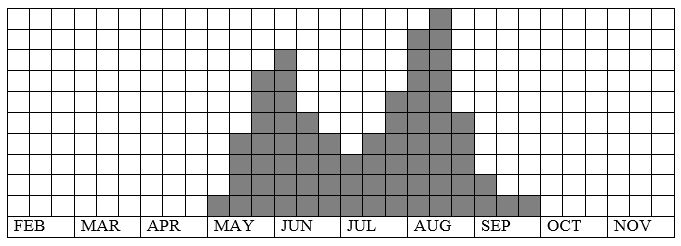
Fig. 62-2. Polyommatus icarus, habitat characteristics.
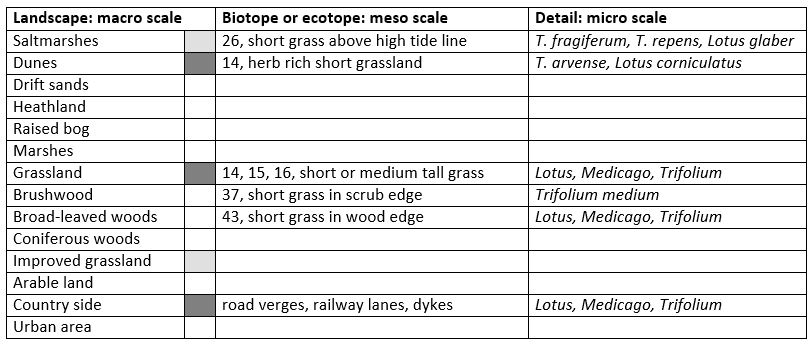
Fig. 62-3. Polyommatus icarus, climate matrix, heat-sums 300 - 3000°d.
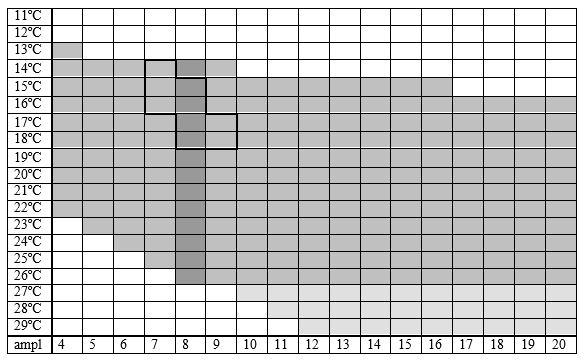
|










